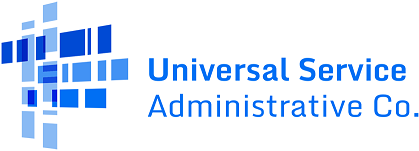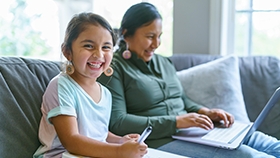About USAC
Our Mission
Dedicated to achieving universal service.
This important principle suggests that everyone in the U.S. deserves high-speed connectivity that is:
The USF + USAC + FCC
As an independent not-for-profit designated by the FCC, USAC administers the Universal Service Fund (USF). The USF is almost $10 billion and is available annually thanks to the companies and institutions that make universal service possible.
USF Programs
With the guidance of policy created by the FCC, we collect and deliver funding through four programs focused on places where broadband and connectivity needs are critical. These programs serve people in rural, underserved, and difficult-to-reach areas.
E-Rate
Keeping students and library patrons connected to broadband services
Rural Health Care (RHC)
Supporting healthcare facilities in bringing medical care to rural areas
Lifeline
Lowering the monthly cost of phone or internet service
High Cost
Expanding voice and broadband networks in underserved areas
Tribal Nations
Working at the infrastructure, community, and individual level, Universal Service Fund programs help connect Tribal communities to phone and broadband services. For more information and resources, go to our Tribal Nations Section.
Service Providers
Telecommunications companies support our mission in two critical ways: contributing money to the Universal Service Fund and participating in the USF and Congressional Response Programs. Learn more about both service provider roles.
Congressional Response Programs
In response to the COVID-19 pandemic, Congress created multiple programs to help people stay connected during and beyond this disruptive period. The FCC designated USAC to administer these programs and funds.
From 2021 to 2024, the Affordable Connectivity Program helped low-income households pay for internet service and connected devices. Due to a lack of additional funding from Congress, the last fully funded month of the program was April 2024.
The Emergency Connectivity Fund Program is a $7.17 billion program that will provide funding to schools and libraries for the purchase of laptop and tablet computers, Wi-Fi hotspots, routers, modems and broadband connections for use by students, school staff, and library patrons at locations that include locations other than the school or library during the COVID-19 pandemic.
During the initial application filing windows, schools and libraries will be able to apply for funding for eligible equipment and/or services purchased between July 1, 2021 and June 30, 2022 to meet the remote learning needs of students, school staff, and library patrons who would otherwise lack access to connected devices and broadband connections sufficient to engage in remote learning.
For more information, visit EmergencyConnectivityFund.org.
The COVID-19 Telehealth Program provides funding to eligible health care providers that offer telehealth or connected care services throughout the country and enables patients to access necessary health care services while helping slow the spread of COVID-19.
After completing a first round of funding in 2020, this Program will distribute a second round of funding in 2021. Amounts from the new appropriation, to the extent possible, should go to at least one applicant in each state and DC, since the date of inception, unless there is no applicant eligible.
The Program will end when funding is exhausted. For more information, visit our COVID-19 Telehealth homepage.
From April 2021 to early 2022, the Emergency Broadband Benefit Program helped low-income households afford broadband services and connected internet devices during the pandemic. The Affordable Connectivity Program replaced this program until it ended in April 2024 due to a lack of additional funding from Congress.






